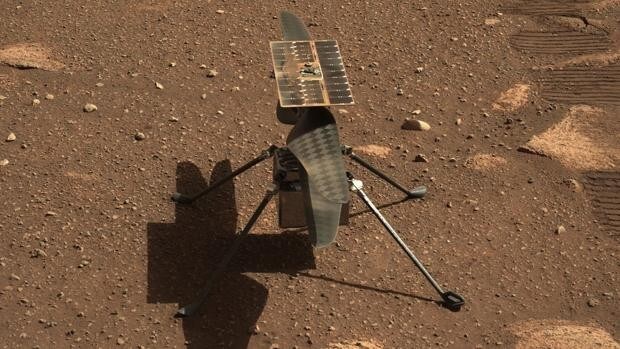 NASA announced over the weekend that the maiden flight of Ingenuity, the first helicopter to soar on another world, has been delayed for a few days. The cause: a problem with a watchdog timer that alerts of any potential problems and puts the drone into "safe mode" if something does go wrong. The problem was detected while the helicopter was attempting to transition from "preflight" mode to "flight" mode during a maximum rotor speed test. NASA has confirmed that Ingenuity is undamaged, is in good condition, and will attempt the feat again soon, starting next Wednesday, April 14.
NASA announced over the weekend that the maiden flight of Ingenuity, the first helicopter to soar on another world, has been delayed for a few days. The cause: a problem with a watchdog timer that alerts of any potential problems and puts the drone into "safe mode" if something does go wrong. The problem was detected while the helicopter was attempting to transition from "preflight" mode to "flight" mode during a maximum rotor speed test. NASA has confirmed that Ingenuity is undamaged, is in good condition, and will attempt the feat again soon, starting next Wednesday, April 14.
Once NASA—which is working around the clock to analyze the data sent back by the helicopter—clarifies the cause of the problem, engineers will once again reschedule the first flight of human technology on another world. But this milestone must be established within a carefully thought-out schedule, as both Ingenuity's design and the conditions on Mars mean that several factors influence the success (or failure) of the mission.
Neither at night, nor very early, nor very late
"For starters, Ingenuity can't fly at night," he explained in a statement.
Bob Balaram, chief engineer for the Mars Helicopter Project at NASA's Jet Propulsion Laboratory (JPL). "It relies on its camera to observe the ground as it flies, and that wouldn't be possible at night." In fact, if it weren't for this detail, nighttime wouldn't be a bad time for a helicopter to fly over the Red Planet, as the air density would be greater and maneuvers would be easier.
In addition, engineers also have to consider Ingenuity's endurance: Each flight consumes many hundreds of watts, and the lithium-ion battery—which powers the two main propulsion motors and six blade control motors—"needs to handle power surges as the helicopter flies and battles winds and gusts in the air," Balaram says. This means it needs to maintain the voltage so the motors don't stall or electronic devices don't experience issues. And because Ingenuity emerges from the cold Martian night with little power, "it needs to bask in the sun to warm up and let the solar panel charge the battery enough to handle the day's power demands." All of this means Ingenuity can't fly too early in the morning.
"Midday and early evening are much better," Balaram notes. But the flight can't happen in the late afternoon either: "The batteries could run out without giving the system time to recharge, and we don't want to go back into that cold Martian night without some power..." Ingenuity has to stay "warm" during the dark hours, when temperatures drop to minus 80 degrees Celsius.
Perfect coordination with Perseverance
On the other hand, Ingenuity needs to be a "good guest," and even though it's no longer inside Perseverance, it needs to coordinate all its maneuvers with it. The rover keeps an eye on it with its cameras, but its systems need to know at all times when it's going to carry out its tasks and tests. And all this taking into account that Perseverance continues to prepare for the mission's main objective, which is to explore Jezero Crater in search of possible remains of ancient life on Mars: there are times when the rover is focused on, for example, sending a large volume of data with images of its surroundings and wouldn't be able to pay attention to the small helicopter. Or with its cameras analyzing certain remains, like the strange green rock that Perseverance found a few days ago. That's why all the equipment must be perfectly synchronized.
The weather forecast on Mars
Mars is a windy place. That's why Ingenuity was tested in a capsule that attempted to simulate the currents on our neighbor, using data recorded by other devices on the red planet's surface and computerized mathematical models. "But we can't test the full range of wind conditions one might experience on Mars," Balaram points out. "The greatest risk is during takeoff and landing, when an untimely gust could present a major challenge." That's why technicians need to have the "weather report" on our neighbor, for which Perseverance's MEDA instrument (with a Spanish contribution), a sort of on-the-ground meteorological station, is very useful. In fact, during last Friday's press conference, MiMi Aung, head of the Ingenuity project at NASA's JPL, stated that winds of around 6 meters per second were expected for the coming days, below the maximum of 11 m/s that Ingenuity could withstand.
So the operations team has a lot of work to do these days to reschedule the historic event. Let's hope it doesn't take too long.
